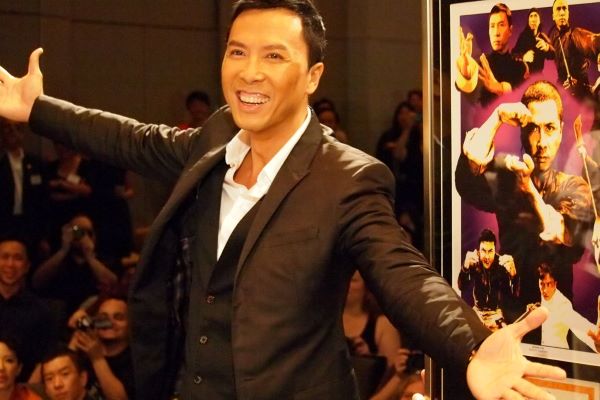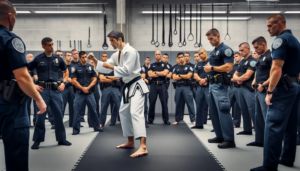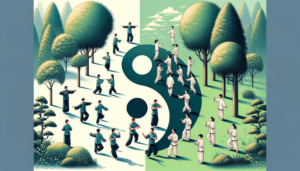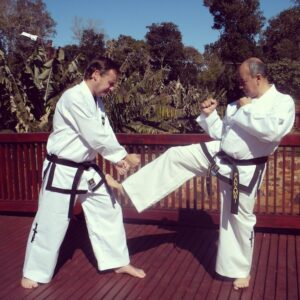
Welcome to the world of Donnie Yen, a martial arts legend whose mastery extends across a dozen martial arts.
From the graceful movements of tai chi to the speed and directness of wing chun, Yen’s journey through the martial arts landscape is nothing short of remarkable.
In this article, we delve into the martial arts known by Donnie Yen, exploring the belts he’s earned, his unique fighting style, and the rigorous training and diet that has shaped him into one of the greatest martial artists of our time.
Contents
What Martial Arts Does Donnie Yen Know? (Timeline)
Donnie Yen knows 13 martial arts, which are: kung fu, wudangquan, taekwondo, wushu, boxing, tai chi, wing chun, MMA, Brazilian jiu-jitsu, judo, kickboxing, Muay Thai, and wrestling.
While the exact timeline of Donnie Yen’s martial arts learning is unknown, here are the martial arts Donnie Yen knows and the potential order in which he learned them.
1. Kung Fu
Donnie Yen’s first martial art was kung fu. He started practicing kung fu at around 7 years old in 1970, under the guidance of his mother.
Kung fu is a broad term encompassing various Chinese martial arts styles, known for their fluid movements, acrobatic techniques, and emphasis on both internal and external strength.
2. Wudangquan
Alongside kung fu, Donnie Yen also started to practice Wudangquan.
Wudangquan is a group of Chinese martial arts originating from the Wudang Mountains, known for their focus on internal power, balance, and harmony between mind and body.
3. Taekwondo
Donnie Yen’s third martial art was taekwondo, which he started around 13 years old in 1976. Taekwondo is a Korean martial art characterized by its emphasis on head-height kicks, jumping and spinning kicks, and fast kicking techniques.
Taekwondo was the logical next martial art, as he’d moved to America 2 years prior, settling with his family in Boston, where taekwondo was becoming very popular.
He also started taekwondo because he wanted to learn a martial art that he believed was more practical than kung fu and Wudangquan.
Soon after moving to Boston, Donnie joined a gang in Chinatown, Boston. The gang would share fighting tips and knowledge, and would often fight with other gangs in the street.
This earned Donnie Yen a reputation as a brawler and gave him more reason to start taekwondo. He wanted to refine his technique and improve his martial arts skills so that he could defend himself.
His taekwondo kicking skills were first used in his fifth movie, The Line of Duty 4 (1989). He has gone on to earn a 6th-degree black belt in taekwondo.
4. Wushu
The next martial art Donnie Yen learned was wushu, at age 16. Wushu is a modern exhibition and full-contact sport derived from traditional Chinese martial arts, known for its dynamic movements and acrobatic techniques.
The decision to start wushu was more his mother’s than his own, as she was the founder of the Chinese Wushu Research Institute in Boston, a kung fu/wushu school.
Donnie was sent to train with the Beijing Wushu Team, which is where he met another future martial arts superstar, Jet Li.
He spent 2 years at the school before returning to America at 18 years old. In America, he started to compete in various wushu competitions, winning gold several times.
It was at these competitions that he began to get noticed by film producers and directors.
5. Boxing
After his intensive training in wushu, Donnie Yen sought to expand his martial arts repertoire and began training in boxing.
He was heavily influenced by Sylvester Stallone to start boxing and weightlifting, who starred in the 1976 movie, Rocky.
This phase of his martial arts journey started around the age of 18, following his return to Boston from Beijing.
Boxing, known for its focus on punches, footwork, and strategy, offered Donnie a new dimension to his martial arts skills.
He spent time at a boxing gym in Roxbury, which was about an hour’s subway ride from his home.
These gyms were primarily for serious fighters and trainers, but Donnie found his place in the community. Despite being a “skinny Asian kid” in a predominantly different environment, the fighters welcomed him, held the bag for him, and taught him valuable techniques.
Donnie’s foray into boxing further honed his control, speed, and power, elements that would later contribute to his versatility as a martial artist and action star.
He first used his boxing skills in his fifth movie, The Line of Duty 4 (1989).
6. Tai Chi
The next martial art Donnie Yen learned was Tai Chi. He started practicing Tai Chi in preparation for his second movie role in 1984 (aged 21) in the film “Drunken Tai Chi”.
Tai Chi is a Chinese martial art known for its slow, flowing movements that emphasize relaxation, balance, and internal energy.
At this stage in his life, Donnie was transitioning from a martial artist to a film star. The opportunity to star in “Drunken Tai Chi” required him to delve into the intricacies of Tai Chi, not just as a martial art but as a performance art for the silver screen.
This period marked a significant shift in his career, as he began to merge his martial arts expertise with his acting skills.
7. Wing Chun
After mastering Tai Chi, Donnie Yen started learning wing chun, a Chinese martial art that emphasizes close-range combat, quick punches, direct straight-line movements, and tight defense.
His introduction to Wing Chun came in preparation for his role in the 1994 movie “Wing Chun”, where he played Leung Pok-to, a character skilled in martial arts.
While the film is a martial arts comedy and not focused on intense fight sequences, Yen’s commitment to authenticity would have required him to learn the basics of wing chun.
This experience served as a foundation for his later, more significant role as the wing chun grandmaster Ip Man in 2008, where his portrayal brought martial arts to a global audience.
In preparation for Ip Man, Donnie Yen began intense wing chun training for 9 months, under the guidance of Ip Chun, Ip Man’s first son. He learned very fast because he’d already learned the basics of wing chun in the mid-90s.
Thereafter, Wing Chun became a pivotal part of Yen’s martial arts repertoire and identity, influencing his fighting style in subsequent films and contributing to his reputation as a versatile and skilled martial artist.
8. MMA (Mixed Martial Arts)
Donnie Yen is widely credited for bringing mixed martial arts (MMA) into mainstream East Asian cinema by choreographing various MMA techniques and moves in many of his films since the early 2000s.
His exposure to MMA heightened when he returned to the United States from 2000 to 2003, due to the emergence of MMA promotions like the UFC.
During this time, he took the opportunity to learn various martial arts forms commonly used in MMA, such as Brazilian jiu-jitsu, judo, kickboxing, Muay Thai, and wrestling.
Yen’s progress in MMA was evident when he returned to Asia, where he implemented his newfound knowledge in films such as “SPL: Sha Po Lang” (2005), “Flash Point” (2007), and “Special ID” (2013).
9. Brazilian Jiu-Jitsu (BJJ)
Following his introduction to MMA, Donnie Yen delved into Brazilian jiu-jitsu (Bjj), a martial art and combat sport focusing on grappling and ground fighting.
His interest in Bjj was sparked by the emergence of MMA competitions and the dominance of the Gracie family in the early UFC tournaments, who showcased the effectiveness of jiu-jitsu against skillful and much larger opponents.
Eager to incorporate this new dimension into his martial arts repertoire and subsequently into his films, Yen sought out tapes of MMA fights, focusing on the Gracie’s performances.
As of 2024, he holds a purple belt in Bjj, showcasing his proficiency and commitment to his first grappling art.
10. Judo
After exploring Brazilian jiu-jitsu, Donnie Yen continued to expand his grappling skills by training in judo, a Japanese martial art known for its throws, joint locks, and chokes.
Judo’s emphasis on using an opponent’s force against them complemented Yen’s existing martial arts skills and added another layer to his combat repertoire and on-screen performance.
Yen’s dedication to mastering judo is evident in his achievement of a black belt in the discipline. This level of proficiency indicates a deep understanding and skill in the art, further showcasing his commitment to being a well-rounded martial artist.
His training in judo and Bjj has contributed to Yen’s versatility as a striker and grappler in action choreography and his ability to perform a wide range of martial arts techniques in his films.
11. Kickboxing and Muay Thai
In his quest to become a versatile mixed martial artist, Donnie Yen also trained in kickboxing and Muay Thai.
Both of these striking arts are known for their powerful and efficient techniques, with kickboxing focusing on punches, kicks, and footwork, while Muay Thai, also known as ‘The Art of Eight Limbs’, incorporates the use of fists, elbows, knees, and shins, as well as some standing grappling (clinching).
Yen’s training in these disciplines further enhanced his striking abilities and added a dynamic range to his fight scenes.
The influence of kickboxing and Muay Thai can be seen in his films, where he often showcases a blend of different martial arts styles, creating a unique and exciting fighting style that has become his signature.
12. Wrestling
To round out his martial arts skills, Donnie Yen also trained in wrestling. Wrestling is a combat sport focused on grappling techniques such as takedowns, throws, and pins.
It emphasizes physical strength, technique, and control, making it a valuable addition to Yen’s martial arts repertoire.
Yen’s training in wrestling complements his other grappling arts, such as Brazilian jiu-jitsu and Judo, providing him with a comprehensive understanding of standing and ground grappling and control.
This diverse skill set has enabled him to perform a wide variety of martial arts techniques in his films, showcasing his versatility and prowess as a martial artist.
What Is Donnie Yen’s Fighting Style? (Martial Art Style)
With a lifelong practice and mastery of numerous martial arts, Donnie Yen identifies himself as a mixed martial artist (MMA).
His fighting style in movies predominantly features wing chun and kung fu, simply because he’s in movies focused on these martial arts, roles that he excels in.
However, in many movies, he also shows a diverse array of MMA techniques, showcasing his versatility and adaptability.
In terms of his martial arts psychology, Yen believes in the synergy of combining multiple martial arts to create a cohesive and effective fighting style.
He has stated, “When you watch my films, you’re feeling my heart”. This sentiment reflects his passion for martial arts and his dedication to authenticity in his performances.
Yen advocates for practical combat, and in his view, MMA represents the most genuine form of practical combat due to its integration of various disciplines. This sentiment is also shared by other famous martial arts actors such as Michael Jai White.
Throughout his career, Yen has seamlessly blended striking arts like boxing, kickboxing, and Muay Thai with grappling techniques from Brazilian jiu-jitsu, judo, and wrestling.
This comprehensive skill set has allowed him to choreograph and execute fight scenes that are visually stunning and grounded in practical martial arts. It also separates him from other martial arts actors who are limited to a few arts.
Can Donnie Yen Fight For Real?
The question of whether Donnie Yen can fight for real often arises, primarily due to his status as a martial arts actor and action director.
However, the answer is a resounding yes—Donnie Yen can fight for real, especially if matched against someone of a similar weight and age (60 years old).
He remains in exceptional condition, both physically strong and fit, as well as mentally resilient, with a wealth of martial arts experience and knowledge. He has been bodybuilding since his early teenage years.
Yen’s real-life combat skills aren’t just for show. He was involved in street brawls as a young teenager, around the time he was learning taekwondo, which gave him practical experience in handling real-life confrontations.
This early exposure to street fighting helped him develop a sense of practicality in combat that has carried through to his film career.
Moreover, other martial arts film stars such as Jackie Chan and Jet Li have praised Yen, with some suggesting that he may be the best fighter in terms of practical combat in the East Asian cinematic universe. This is a testament to his prowess and reputation among his peers.
World-class fighters, including former Strikeforce Middleweight Champion Cung Le and former World Boxing Heavyweight Champion Mike Tyson, who’ve worked with Yen in films like “Bodyguards and Assassins” and “Ip Man 3”, have also vouched for his martial arts skills.
They claim that Yen is an incredible martial artist who would also excel in authentic combat situations.
During the filming of “Ip Man 3”, there was concern that Tyson, a professional boxer, might accidentally injure Yen.
However, Yen fractured Tyson’s finger with his elbow while blocking punches, further showcasing his ability to handle himself against a formidable opponent.
In conclusion, Donnie Yen’s martial arts expertise extends beyond the silver screen. His training, experience, and physical conditioning affirm he’s more than capable of handling real-life combat situations, making him a true martial artist in every sense of the word.
Donnie Yen’s Training (New and Old Styles)
In 2024, Donnie Yen’s training is focused on martial arts, stretching, and calisthenics (lots of pushups and bodyweight exercises).
At 60 years old, Donnie Yen no longer trains with heavy weights, as he feels he can remain strong without them. He also doesn’t need to bulk up and add a lot of muscle mass, which heavy weights are perfect for.
His martial arts training is focused on speed and technique. He stretches multiple times per week to stay flexible and injury-free so that he can perform his martial arts techniques with ease.
Donnie Yen likes to box to maintain his technique and cardiovascular endurance. He either hits the heavy bag or pads, or shadowboxes.
He also trains his mind. Donnie Yen chooses to think positively and see age as just a number. In this way, he keeps himself young in mind and heart and motivated to continually train every week.
When Donnie Yen was training in his 20s and 30s, he practiced martial arts techniques for many hours. He would do 10,000 side kicks on a hanging bag, and many other techniques, until he mastered them.
This repetitious training was how he’d prepare for each movie role. He would also intensely study the martial art style that his character would know, and bring in experts to help him perfect the techniques, movements, and craft.
His dedication to this style of training is how Donnie Yen learned 13 martial arts and experimented with many others. It’s the reason he views himself as a mixed martial artist.
Donnie Yen’s Diet
When it comes to his diet, Donnie Yen believes in eating a balance of proteins, carbohydrates, and healthy fats. He says, “I eat anything. Anything I desire to. But, there’s a balance to it.”
He sees treats, or cheat meals, as part of a balanced diet, as long they’re eaten in moderation. He also emphasizes cutting down on red meats and processed foods for optimal health and longevity.
Here’s what a typical day of eating for Donnie Yen looks like:
Breakfast:
- A slice of seeded bread with savory salmon
- Half an avocado
- 3 poached eggs
Lunch:
- Chicken or tuna
- Rice
- Broccoli or other greens
- French fries (on the days he needs more energy)
Dinner:
- Chicken or fish
- Vegetables
- Carbohydrate of choice (pasta, potato, rice)
Snacks throughout the day:
- Flax seeds and blueberries
- Hemp seeds and peanut butter mixed with cashew milk
- 90% dark chocolate
While Donnie Yen’s diet is focused on a balanced diet, he’s no stranger to extreme diets. In 2007, for his role as Ip Man, Donnie Yen went on a strict diet consisting of mostly lean proteins (fish and meat) and vegetables.
He did this to reach the weight of 54 kg (120 lbs), roughly 30 lbs lower than his average weight.
Donnie Yen Martial Arts FAQ
Here are some frequently asked questions about Donnie Yen’s martial arts.
Donnie Yen Martial Arts Belts: Does He Have Any?
Donnie Yen has martial arts belts in 3 disciplines:
- Brazilian jiu-jitsu – purple belt
- Judo – black belt
- Taekwondo – 6th-degree black belt
How Many Martial Arts Does Donnie Yen Know?
Donnie Yen knows 13 martial arts. They are kung fu, wudangquan, taekwondo, wushu, boxing, tai chi, wing chun, MMA, Brazilian jiu-jitsu, judo, kickboxing, Muay Thai, and wrestling.
Where Did Donnie Yen Learn Martial Arts?
Donnie Yen learned martial arts under the tutelage of his mother, Bow-sim Mark. She was a Chinese martial arts grandmaster, specializing in tai chi and Shaolin kung fu.
She started teaching Donnie Yen kung fu and wudangquan around the age of 7. When the family moved to Boston, Massachusetts, USA, when Donnie was 11, she continued teaching Donnie martial arts at the school she founded, the Chinese Wushu Research Institute.
Donnie Yen then picked up taekwondo at a local dojo, before moving to Beijing to learn wushu with the Beijing Wushu Team between the ages of 16 to 18.
The Beijing Wushu Team is a renowned martial arts team based in Beijing, China, known for its high skill level and performance in the sport of wushu.
The team has produced many champions and is considered one of the best wushu teams in the world. It is also where Jet Li, another famous martial artist and actor, trained during his youth.
Donnie Yen’s training with the Beijing Wushu Team was a pivotal moment in his martial arts journey. The rigorous training and exposure to a wide range of wushu styles and techniques provided him with a solid foundation in the sport.
This experience honed his skills and deepened his understanding and appreciation of Chinese martial arts.
The discipline, precision, and athleticism he developed during his time with the Beijing Wushu Team would later influence his approach to choreographing and performing fight scenes in his films.
It also opened doors for him to explore and learn other martial arts in the future, as he continued to evolve as a martial artist and action star.
What Are Donnie Yen’s Best Martial Arts Movies?
Donnie Yen’s best martial arts movies are:
- Once Upon a Time in China II (1992)
- Iron Monkey (1993)
- Hero (2002)
- SPL: Sha Po Lang (2005)
- Flash Point (2007)
- Ip Man I, II, III, IV (2008, 2010, 2015, 2019




